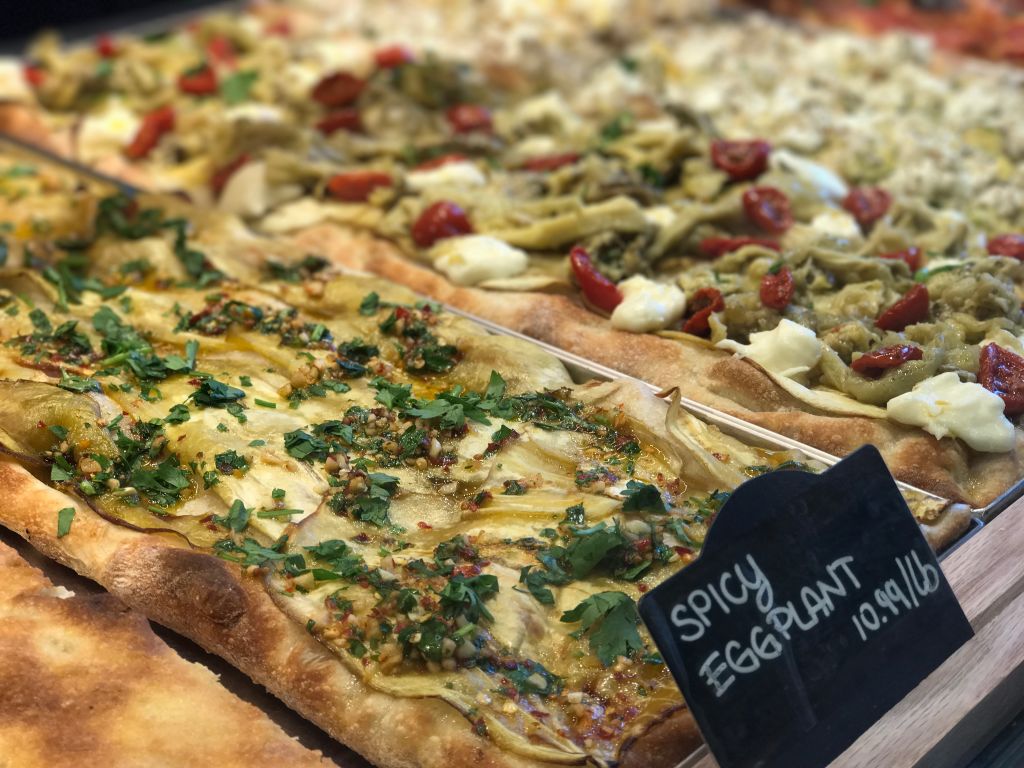
Bonci Opens First Branch Outside Rome…in Chicago
40 year-old Gabriele Bonci looks like he could wrestle a crocodile. As wide as a linebacker, he sports a few colorful tattoos beneath his short-sleeved chef’s coat and speaks in rapid-fire Italian to his young cooks. They all race around the narrow West Loop kitchen, filling orders and answering questions from customers. I witnessed this scene on Day Two of the highly-anticipated pizzeria last week, just a day before Gabriele had to go back to Rome, where he began his pizza business in 2003.
Bonci partnered with a former P.F. Chang’s executive to bring his concept to the U.S. Why Chicago? “We wanted to get to an area where people were food savvy, where they understood food and were willing to try new things,” said Tennessee native Rick Tasman, who was Chief Operating Officer of the Asian restaurant chain for 14 years. His new company – Bonci USA – has the rights to open more stores outside of Italy. “We weren’t trying to redefine what pizza is for Chicagoans, but we wanted people to try it. We liked the urban area and the good foot traffic,” he said. “With the [Morgan Street Green Line] train stop and the young people here, it’s the perfect location.”
The Roman style of pizza is something Chicagoans have only seen elsewhere. Maybe they were on vacation in Europe and tried it; perhaps they saw Anthony Bourdain feature Mr. Bonci on his TV show. There really is nothing even close to what Bonci does in Chicago, even if you count Pizza Metro in Wicker Park, which claims to be Roman but is really just a good thin pizza. Bonci makes Pizza al Taglio, which refers to the sturdy rectangular trays the pizzas bake in, also helping to evenly distribute heat.
Besides the shape, the other important point of difference is the crust’s texture. It somehow maintains an impossibly crispy, light bottom crust, showcasing browned spots and uneven surfaces on the outside. That delicate undercarriage supports a fluffy, pockmarked interior, as light and airy as an artisan bread that’s been left to ferment for days. Calling it a focaccia or a Sicilian would be an insult. Those pizzas have a density and sponginess that Bonci’s pizzas manage to avoid. Tasman says the secret is Bonci’s dough, which contains a blend of Italian 00 flour, as well as whole grain and minimally-processed organic flour. There are two separate fermentations of at least 24 hours each, which build structure and complexity. Baked in handmade Castelli ovens imported from Italy with terra cotta decks, the pizzas bake at 300 degrees, which is probably the lowest temperature of any pizza oven in the region. But due to the special construction of the ovens, they are able to control the heat on both the deck and the ceiling. Dough this delicate doesn’t need a blast furnace, it just needs to be coaxed to life.
Bonci really gets creative with his toppings. Using as many local sources as he can (‘nduja from ‘Nduja Artisans; cheese, olive oil and cured meats from local suppliers; he’s working with the guys at West Loop Salumi on a porchetta) he thinks seasonally about what goes on top. If it’s summer, you’ll see thinly-sliced zucchini with tiny blobs of fresh ricotta and black pepper; fall means pureed pumpkin; spring offers ramps and young garlic. You’ll never see pepperoni, since that’s an American invention. “Ask for pepperoni in Italy and you’ll get green peppers,” says Tasman. They’re more likely to use ‘nduja – my favorite spreadable, spicy Calabrian sausage – often referred to as “pork butter,” but pair it up with fresh, peppery arugula or seasonal mushrooms. Several of the pizzas don’t even contain cheese, which will take Chicagoans some getting used to.
The other aspect of the “al taglio” style of pizza is how it’s ordered. You’re paying by the pound, so simply tell your friendly cook how much you’d like by making a sign with your thumb and forefinger. They’ll position their kitchen shears along the rectangular pizza, ask if that’s sufficient, then cut across the width of the tray and weigh it for you. This allows you to try several styles without committing to enormous slices. I was able to try four different flavors on my first visit, including the strangely addictive mozzarella and potato, and got out of there for $15. Bonci has more than a thousand flavors in his portfolio, but will most likely rotate about 50 of them in Chicago; I, for one, hope to be able to try them all.
Bonci
161 N. Sangamon Street
248-705-0402
Pizzas cost $8.99 – $16.99 per pound


This pizza is incredible. We were just in Rome and ate there 3 times. Wish they would open one in calif. It’s truly the best
Hey love this article. I myself have a castelli and trying to learn the oven. Do you know what temperature they bake the base at ? I know 300 C for baking the pizza with toppings. Thanks
I believe it’s 320 C.